Walking and the elliptical trainer share a lot of benefits but differ in some key areas. Here is a detailed comparison between these two forms of physical exercise so you can choose the one that is right for you.
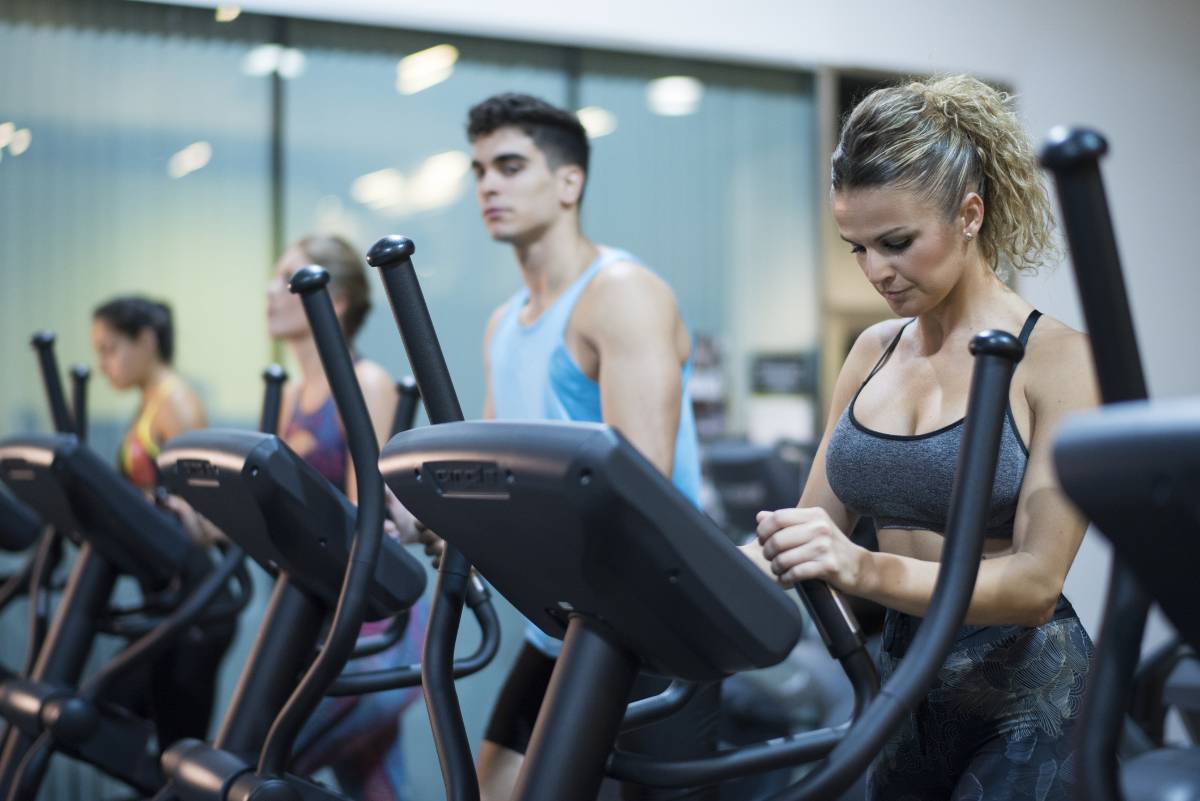
The elliptical machine is one of the most popular of the cardio machines in the gym, thanks to the fact that it delivers a full-body workout in a way few other machines truly can.
But it’s not the only cardio workout you should be doing. In fact, it may not even be the “best” use of your time and effort.
Since the beginning of time, walking has been the go-to not only as a means of getting around, but also getting in daily exercise. It’s something we do all day long, a great way to burn calories and increase our overall fitness.
The question is: which is better, walking or elliptical training?
That’s what we’ll analyze in this article!
Below, I’ll take you through the eight factors I consider most important for any cardio workout, and compare how walking matches up against elliptical training.
By the end of this post, you’ll have a much clearer idea of which of the two is the better way to train.
Elliptical vs Walking – Calories Burned
It’s always best to start off with the one quantifiable factor in any workout: the calories burned. After all, we’re exercising for the express purpose of burning calories (especially fat calories), so any workout that burns more calories seems like the better use of our time at the gym, right?
Let’s start off with the tried-and-true option: walking.
According to Harvard Medical School1, a 185-pound person will burn around 159 calories in 30 minutes of walking at 3.5 MPH. Pushing it a bit faster to the upper-end of “average” walking pace, 4 MPH, that calorie-burn rises to 189 calories in 30 minutes.
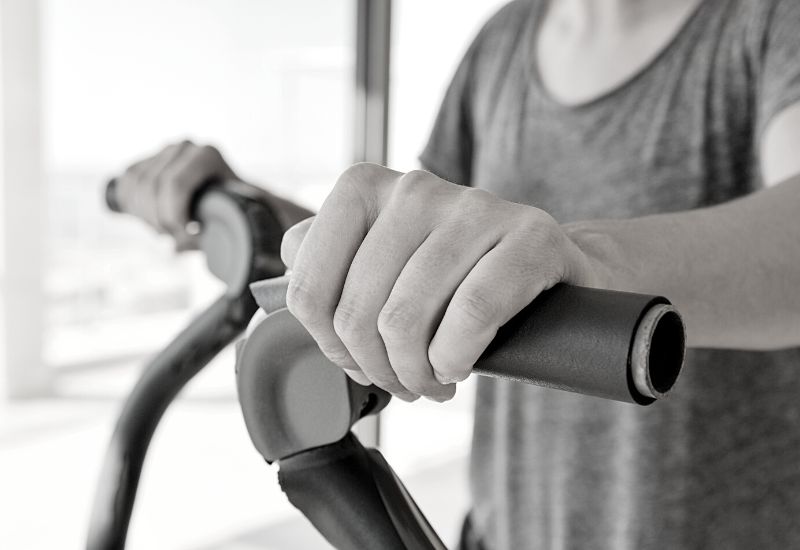
Add in the occasional jog or pick up the pace to a fast walk, and that same 185-pound person will burn around 250 calories in 30 minutes.
Not a bad start, right? Considering you can usually walk for hours at a time without feeling fatigue, it’s a solid option for burning calories.
But if you don’t have hours to spend walking, but you’ve got to get in your workout and burn a lot of calories quickly, the elliptical is definitely the better choice.
The number of calories burned on the elliptical machine by that same 185-pound person is 378 in a 30-minute training session. And that’s just the “average”, meaning walking at a slightly-faster-than-normal pace with light resistance and some incline. Push your pace faster, add more resistance, add incline, or mix in some HIIT, and your calorie-burning will only increase from there.
In terms of maximum calories burned in the shortest amount of time, the elliptical is the clear winner in this case!
Elliptical vs Walking – Weight Loss
Of all the cardio machines for weight loss, the elliptical is easily in the top three—along with the treadmill and the rowing machine.
These machines all give you an option for high-intensity exercise (see the “HIIT Workouts” section below) and help you move your body in the way that burns the most amount of energy during your training.
The elliptical machine, in particular, is highly effective for weight loss because it engages all of the muscles in your body (more details to come in the “Muscles Worked” section).
By recruiting all these muscles, you burn through your available energy supply (stored in the muscles, your bloodstream, and your liver) more quickly.
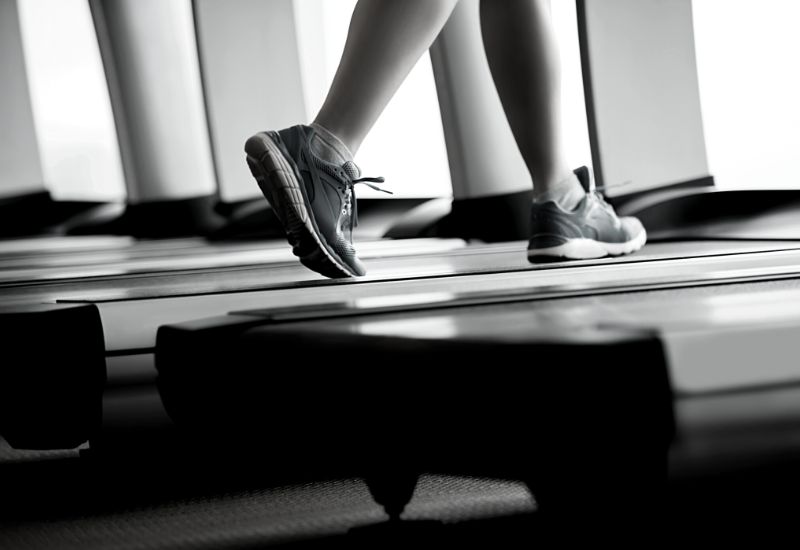
To keep your muscles powered up and moving, your body is forced to tap into stored fats, leading to fat-burning—which, as we all know, is the real effective way to lose weight.
Walking, while effective at burning calories, will activate stored fats within the first 10 to 15 minutes of exercise, but it won’t burn through your stored energy supply as quickly, so less fat will ultimately be burned.
You can burn a lot more calories by walking for hours every day, but on the “average” busy day where you only have 30 to 90 minutes for a workout, the elliptical wins by virtue of being the more efficient fat-burner.
Elliptical vs Walking – Cardio
When we talk about “cardio”, we’re referring to “cardiovascular endurance”, which is developed when you push your cardiovascular system (lungs, heart, and blood vessels) to work harder to deliver oxygenated blood around your body.
When you push your pace, such as by speed-walking or working out on the elliptical, the muscles in your heart grow stronger as they work harder, your aerobic capacity increases to absorb more oxygen via your lungs, and your blood vessels dilate more effectively to allow for better blood flow. Essentially, the harder you push, the more you’ll improve your cardio conditioning.
While walking is an amazing form of cardio, one that plays a crucial role in your fitness, the elliptical does a much better job of improve your cardiovascular endurance overall simply because it can push your heart and lungs and blood vessels to work harder!
Elliptical vs Walking – Functional Fitness
I’m all about the “functional” training style—a.k.a. workouts that help me to go about my activities of daily life more effectively.
One of the great benefits of elliptical trainer workouts is that they help to strengthen the muscles that you’ll use every day. For example, the muscles that you’ll use to bend over and pick up heavy groceries, lift boxes to and from shelves, carry your kids, walk your dog, or climb stairs.
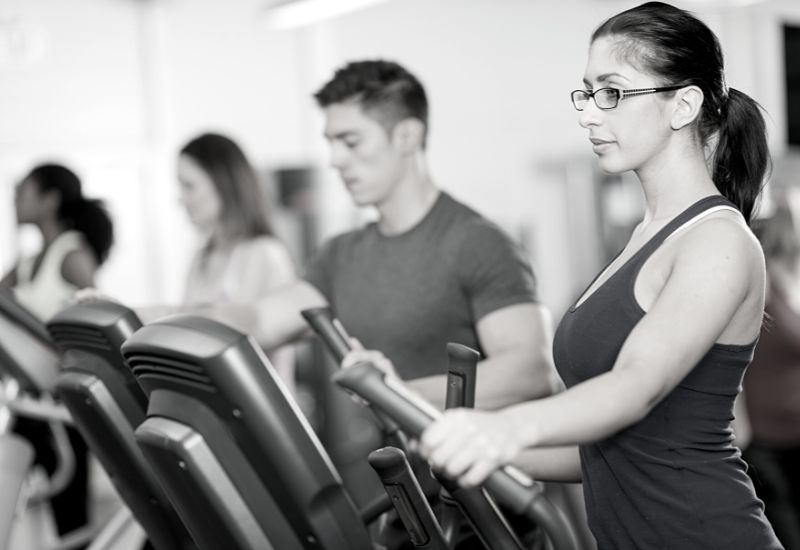
You’ve got lots of training options to choose from that will encourage better functional fitness, making you better able to go about your day without feeling fatigue or strain in whatever activity you’re doing.
Walking, too, is a highly functional form of exercise. The more you walk, the more you’re able to walk because you’re training your muscles to endure prolonged periods of exercise. That’s why hikers often start with “short” 2-5K hikes, but slowly work their way up to 10, 20, and even multi-day, 100+ mile hikes.
Or, they can spend an entire day walking around a city and exploring it on foot (which I absolutely prefer to seeing it from a car or taxi).
Elliptical training will help you to develop more walking power, so it’s a highly functional form of training. But when it comes to training to walk more, the best way to do so is just to walk more.
Elliptical vs Walking – HIIT Workouts
HIIT is one of the most efficient and effective forms of exercise.
The high-intensity periods push your cardiovascular and muscular endurance to their absolute max capacity, and the low-intensity periods give you just enough recovery time that you can do it all over again—and again and again.
The result is serious calorie-burning and fat-burning, an amazing metabolism boost, and better cardio and muscular conditioning.
As you’ve seen in my elliptical trainer HIIT workout article, the elliptical machine is, hands down, one of the best HIIT machines in the gym. To push yourself to the max, you’ve got lots of options:
- Speed up the pace to pedal as fast as you can
- Maximize the resistance to make pedaling/working the handles challenging
- Set incline to the highest level so it feels like you’re climbing stairs
- Squat-walk to give your leg muscles a true challenge
It’s truly versatile compared to any other cardio machine in the gym—and definitely more versatile than walking.
With walking, you can never really push into the “high intensity” realm.
Walking is, by definition, a fairly low-intensity form of exercise, one that can be sustained for long periods of time, but will never really get your heart pumping and your blood flowing in the way only high-intensity exercise can.
It’s only when you speed up from a walk to a sprint or fast run that you get in the “HI” part of HIIT.
Elliptical vs Walking – Muscles Worked
Walking is all about those leg muscles! Your quads, glutes, and hamstrings get most of the attention, but your calves and shin muscles also do the work. If you tackle hills, stairs, inclines, or declines, you switch up the emphasis on your muscles for a more versatile workout.
Your lower back also has to do a lot of work to keep your upper body stable, upright, and supported while you walk. Over the course of a few hours, you’ll definitely feel your spinal muscles getting tired.
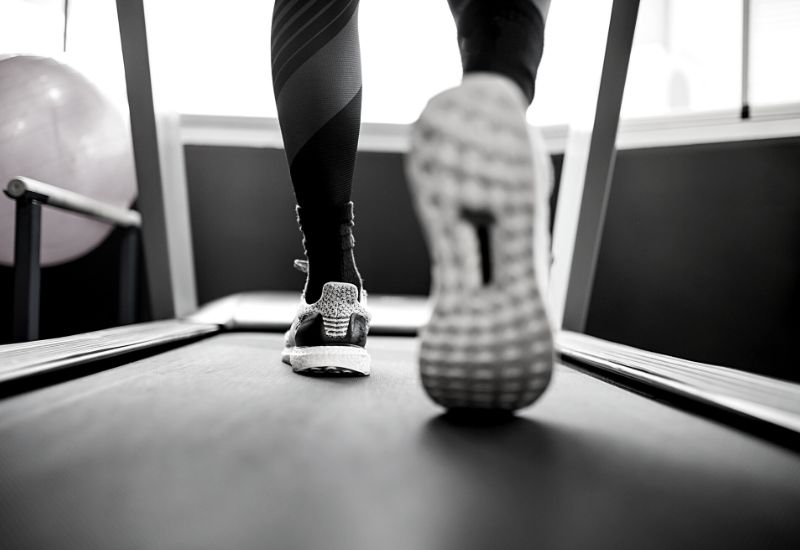
On the other hand, elliptical training works all of the muscles in your body. And yes, I do mean “all.”
Take a look at the list of muscles worked on the elliptical machine and you’ll see what I mean:
- Upper body muscles: Chest, upper back, shoulders, triceps, biceps, and forearms
- Core muscles: Abs, obliques, and lower back spinal muscles
- Lower body muscles: Hamstrings, glutes, quads, calves, and shins
The only other cardio machine that can recruit as many muscles is the assault bike (or air bike). Even the rowing machine fails to recruit the “push” muscles (chest and triceps), while virtually every other cardio machine is focused primarily on the lower body.
In terms of muscles worked, you just can’t beat the elliptical!
Elliptical vs Walking – Impact
As you saw in my elliptical vs running article, high-impact exercise can take a toll on your joints. For example, when you run or climb stairs, there is impact on your musculoskeletal system every time you plant your front foot and shift your weight onto it.
While high-impact exercise is good for strengthening your joints, muscles, and bones, too much high-impact exercise can lead to strains and injuries. That’s why it’s recommended to mix up both high and low-impact exercise in your weekly training program.
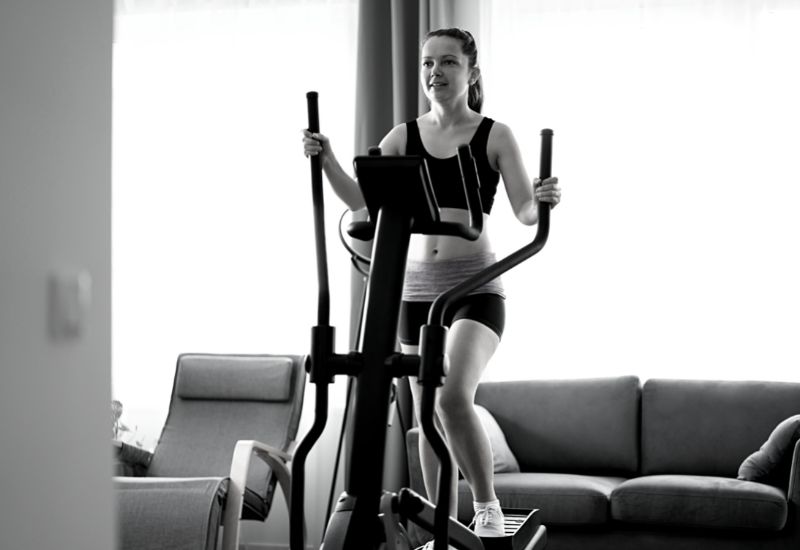
Both walking and elliptical training are low-impact forms of exercise, however, walking surprisingly has more impact than elliptical training.
Because on the elliptical, you never lift your feet off the pedals, there is no impact from putting them down again. You simply glide forward and shift your weight onto your front foot smoothly, no impact at all.
Walking has some impact because you have to lift your feet and put them down again. However, because of the slower pace, it’s low-impact enough that won’t be any more fatiguing or damaging to your joints than elliptical training.
In fact, it will actually strengthen your joints and muscles and make them better-able to sustain the effort of prolonged walks in the future.
Elliptical vs Walking – Enjoyment
I like to talk about enjoyment last because though it’s not a critical part of the workout itself, it’s a necessary factor to evaluate in any training program.
Why is it necessary? Simple: if you don’t enjoy your workout, you’ll have a much harder time doing it. Eventually, you’ll lose motivation and ultimately stop working out altogether. And that’s absolutely NOT what you want!
So, finding a workout you can enjoy is crucial for your long-term fitness. You want a training method that keeps you mentally engaged as well as physically challenged, that you can enjoy for weeks, months, and years to come.
Most elliptical trainers come with built-in screens for your enjoyment. You can watch TV or a movie, participate in a recorded workout, or listen to your favorite audiobook, podcast, or playlist. Some will include tablet holders where you can read or surf the internet or watch TV/movies. This feature is included with the goal of occupying and entertaining your mind while your body is working out.
But let’s be honest: there’s just something wonderful about walking in the beautiful outdoors. Whether you’re strolling along a lake side, walking down the boardwalk, wandering along a forest trail, or exploring your city, you can’t help but enjoy the time you spend walking outside (weather-permitting, of course).
You can get a lot of enjoyment out of spending time walking outside, under the bright sun, or even in the rain. It may be less fun inside on a treadmill (necessary in the winter months), but still a great way to mix things up and do something different.
The Bottom Line
It’s pretty clear to see which of the two workouts takes the crown in each of these aspects!
There’s no doubt that when it comes to burning calories, encouraging weight loss, improving your cardiovascular conditioning, working more muscles, and pushing your fitness using HIIT, the elliptical machine beats walking hands-down.
On the other hand, you can walk for hours and enjoy every minute you spend outdoors, and it’s the far more “functional” of the two workouts.
At the end of the day, it’s all about including whichever workout makes you happiest and helps you reach your fitness goals.
In a perfect world, you’d include both—walking on the days when you can enjoy hours spent in the sunshine and great outdoors, and elliptical training when you’ve less time to spend and want to maximize fat-burning and muscle training.
More Articles and Guides Like This
3 Beginner Elliptical Workouts (and Why Beginners Should Use the Elliptical). The elliptical machine is one of the best cardio machines for beginners. Here are three beginner-friendly elliptical workouts to get you started.
How to Use the Elliptical Machine Like a Champ (Form, Posture, and Pro Tips). The elliptical is an awesome cardio machine for losing weight in the gym. Here’s a detailed guide on how to use it for maximum effectiveness, whether you are trying to lose weight, get in shape, or burn more fat.
Elliptical Buying Guide – Everything You Need to Know to Buy with Confidence. Want to buy an elliptical but don’t know where to start? Arm yourself with the knowledge to choose the perfect elliptical for you and your workout goals.